-

新人教版高中英语必修2Unit 3 The Internet-Discovering Useful Structure教案一
This unit is about the Internet, which has a great influence to our humans and our lives. During the Listening & Speaking & Talking and Reading and Thinking section, the influence in examples has been shown. Thus, use the Present Perfect Tense is appropriate. However, in order to show the justice or weaken the doer of the behavior/action, it’s better to use the Present Perfect Passive Voice than the Present Perfect Tense. Besides, having learned to use the Present Perfect Passive Voice, students can beautify their language in their writing. 1. Learn the structure of the Present Perfect Passive Voice and its functions. 2. Learn to change the sentences with the Present Perfect Passive Voice into the sentences with the Present Perfect Passive Voice. 3. Learn to write sentences with the Present Perfect Passive Voice flexibly according to the context. 1. Learn the structure of the Present Perfect Passive Voice and its functions. 2. Learn to change the sentences with the Present Perfect Passive Voice into the sentences with the Present Perfect Passive Voice. 3. Learn to write sentences with the Present Perfect Passive Voice flexibly according to the context. Step 1 Observe the following sentences, then change the sentences into passive voice.He has been selected to take part in the sports meeting.(肯定句)他已被挑选出来参加运动会。The ink has not been removed from his overcoat.(否定句)墨迹还没有从他外套上去掉。

新人教版高中英语必修2Unit 3 The Internet-Listening &Speaking&Talking教案一
Listening and Speaking introduces the topic of “ask about online habits”. Many middle school students have been surfing the Internet for many years, but what they do with the Internet and how much time they spend every day may not be very clear to themselves, nor to other students. This section allows students to investigate their peers' Internet use, which is conducive to their mutual understanding and understanding of the Internet. It can also help them reflect on their own online behavior, learn from other people's good online habits, and get rid of their bad online behavior.The listening text of this section is an investigation interview. The investigators interview specific groups with the same questions to obtain information, so as to understand their views, practices or attitudes on this issue. There are two specific questions: “how much time do you spend online every day? What do you usually do online?”. The answers of the three respondents provide rich and different information, and achieve the purpose of the investigators. The oral discourse structure of survey interviews generally includes greeting and explaining the purpose of the interview, presenting the interview questions and the respondents' answers. Listening and Talking introduces the theme of “choosing the right application ". Listening text is a conversation between Laura and Xiao Bo. In this part of listening, “oink”; “piggy bank” may cause the students' hearing comprehension limitation. Oink refers to sound word and pig's sound. So, add some oink to my piggy bank is often used to describe "making a little money".1. Guide students to understand the content of listening texts in terms of listening for definitions.2. Cultivate students' ability to define words and understand an investigation interview.

新人教版高中英语必修2Unit 3 The Internet-Reading For Writing教案一
⑦identity theft 身份盗窃⑧chat room 聊天室⑨draft your blog post 起草博客帖子⑩post embarrassing photos 张贴尴尬照片 【话题句式】 1. How do you stay safe online and avoid bad experiences on the Internet? 你如何在网上保持安全, 避免在网上的不良经历? 2. I’m not an expert, but many years as a blogger have taught me a thing or two. 我不是专家, 但作为一个博主, 我已经学了好几年了。 3. If you see or read something that makes you feel uncomfortable, leave the site immediately. 如果你看到或读到一些让你觉得不舒服的东西, 立即离开这个网站。4. Don’t give out your address or phone number. 别告诉别人你的地址或电话号码。 5. Identity theft is a common and serious problem. 身份盗窃是一个常见而严重的问题。6. Being online is no excuse for being rude, and you don’t want to become a target for a troll or cyberbully. 上网并不是无礼的借口, 你也不想成为发挑衅帖子的人或网络恶霸的目标。 7. Trolls often use several false names so that they can stay on a site. 发挑衅帖子的人经常使用几个假名, 这样他们就可以留在一个网站上。8. However, the more polite you are, the less likely it is you will be attacked. 然而, 你越有礼貌, 你被攻击的可能性就越小。
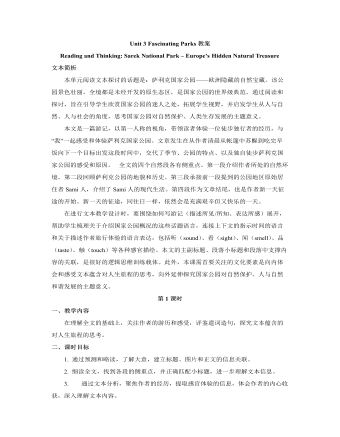
新人教版高中英语选修1Unit 3 Fascinating Parks教案
2. Explore the significance of the establishment of Sarek National Park.Q1: Which event is the most important one in the park’s history?Ss: The establishment of Sarek national park in 1909 is the most important one.Q2: Is it worth making a place like Sarek a national park? Give your reasons.Ss: Yes. In this way, the place can be kept in its natural state and natural beauties and other rare and valuable resources can be preserved instead of being destroyed by endless exploitation driven by profits.Q3: How does the writer organize his introduction to the history of Sarek?Ss: The writer organizes his introduction in the sequence of time, using time indicators such as “used to”, “around 9,000 years ago”, “soon after”, “following the reindeer”, and “in 1909”.Q4: What is the feature of the language used to introduce the history of the park?Ss: The introduction to the park is to provide facts, using time indicators to organize the events. Sentences starts with “third person” and passive voice is used more often, feeling objective.【设计意图】学生寻找和梳理公园历史上的重要事件,体会人与自然的和谐关系,评鉴介绍性语言的特点。【核心素养提升点】发展自主提取、梳理文本信息能力,训练逻辑思维和高阶思维。Activity 3: Highlighting the secret of the text
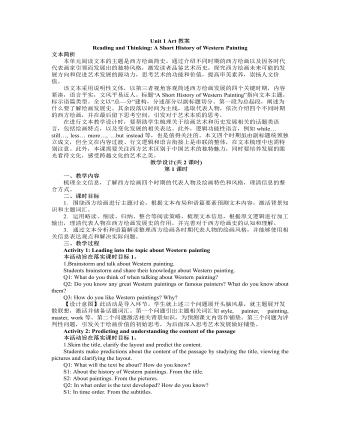
新人教版高中英语选修3Unit 1 Art教案
[2] An important breakthrough…was… [3] Another innovation was … [4] the emphasis increasingly shifted from…to… [5] New ideas and values gradually replaced… [6] While his paintings still had religious themes… … T: All these expressions serve to show how Western painting has developed. Some of them share similar structure but with varied use of words, which makes the text vivid and more readable. 【设计意图】主题类语言整理有助于学生类化语言应用,提高语言输出的丰富性。处理完文本内容信息后,进入语篇信息处理,进行主题相关的词块归类。引导学生快速阅读,寻找表达相同主题(发展或者艺术)的词和短语,再根据词性、用法和结构进行归类,储备主题相关词汇,丰富语言储备,提升语言素养。 Assignment: Go online to gather more information about Chinese painting and write a short history of it. 【设计意图】结合所学,迁移运用,根据实际语境,进行模仿性运用。在此过程中,学生尝试借鉴已学的语言、内容、语篇结构和写作手法来建构新文本,实现语篇输出,同时关注中西艺术文化的差别,加深对优秀文化的认同,培养文化意识。

新人教版高中英语必修1Unit 3 Sports and Fitness-Reading for Writing教案
Then have them write a short paragraph to describe and explain their changes. After that, get the Ss to exchange their drafts with their partners and use the checklist to give feedback on their drafts, and finally revise it.Step 5 Summary of how to write a wellness book1.健康书的审题步骤:第一步:明确要求该写作属于经验分享,故要用第一人称来写;时态以一股现在时为主。第二步:确定段落该类文章可以从以下三个方面人手:Para.1首先表明写作的目的Para.2自己的做法及心得体会Para.3表示期望及感谢第三步:提炼要点2.健康书常见句式:1) It is an honor for me to share my favorite sport with you,2) It makes me feel relaxed playing with my friends.3) It makes me rid myself of stress while playing with my friends.4) Moreover, it provides me a valuable chance to communicate with others.5) I we eat too little or too much, or if we choose the wrong food, we may become sick.6) We can do something to change the poor situation.Step 6Homework假如你的老师让你在班级Wellness Bok上分享自己的亲身经历及心得,请根据以下要点写一篇80字左右的文章1. 你喜欢的运动是什么?2. 你最喜欢的原因是什么?3. 你参加锻炼的体会。

新人教版高中英语必修2Unit 3 The Internet-Reading and Thinking教案一
Paragraph 3. Jan decided to start an IT club to teach old people how to use computers and the Internet. Paragraph 4. Jan has started taking online classes to learn more about how to use the Internet to make society better. Paragraph 5. Jan’s life has been greatly improved by the Internet. Step 5: Critical thinking:(1)How do you arrange your time spent on study and the Internet? Is it reasonable? I usually surf the Internet using my mobile phone for only an hour after class, and it is reasonable for me.(2)What are your online activities? Are they safe? I chat with my friends, read news and play games. I never give away my private information so I think they are safe.Step 4: summary Much has been written about the wonders of the World Wide Web. There are countless articles (1)______(tell) us how the Internet has made our lives more convenient. But the Internet has done a lot (2)_____(much) for people than simply make life more convenient. People’s lives (3) _________________(change) by online communities and social networks so far. Take Jan for example, who developed a serious illness that made her (4)_____(stick) at home with only her computer to keep (5)___(she) company. She joined an online group (6)______ she could share problems, support and advice with others. She considered the ability to remove the distance between people as one of the greatest (7)_______(benefit). She was so inspired (8)____ she started an IT club in which many people have been helped. She has started to learn more about how to use the Internet to make society better. Her next goal is to start a charity website to raise money (9)___ children in poor countries. Jan’s life has been (10)______(great) improved by the Internet. Step 5 Homework:Review what we have learned and find out the key language points in the text.
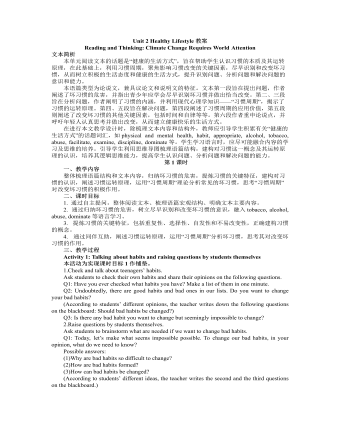
新人教版高中英语选修3Unit 2 Healthy Lifestyle教案
Activity 4: Figuring out the structure and the writing purpose 本活动为实现课时目标2。 1.Read Paragraph 6 and think about its main idea and the writer’s writing purpose. Q1: If you were the author, how would you end your article? “For young people, there is plenty of time to change bad habits. However, there is no “magic pill” or delete button that will help you; you have to think about your bad habits and decide on some changes. You have the power to build a happy and healthy life full of good habits!” Q2: What is Paragraph 6 mainly about? (Possible answer: to appeal to young people including teenagers to change bad habits and live a happy and healthy life.) 2.Think about the writer’s writing purpose and share opinions. Q1: What is the writing purpose? Work in pairs and figure it out. (Possible answer: On the one hand, the passage is written to help teenagers change their bad habits and live a healthy lifestyle. On the other hand, it provides us with a scientific way to identify and analyse our problems objectively, thus strengthening our resolve to tackle the seemingly common yet tough problems in our lives.) 【设计意图】 步骤1旨在预测和验证文章最后一段主要内容,梳理完整的语篇结构,步骤2旨在思考和讨论作者的写作目的。教师也可根据学生课堂反应情况融入对语篇人称多次转换的思考。
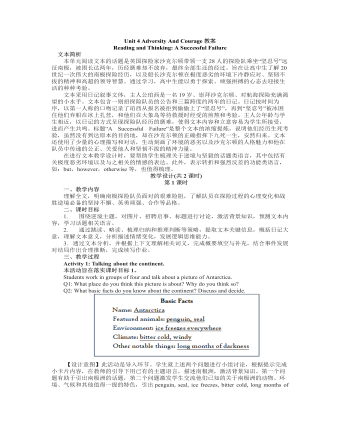
新人教版高中英语选修3Unit 4 Adversity And Courage教案
本活动旨在落实课时目标3。 The Student Union is looking for three students for a 3-week voluntary program in Guizhou province. The volunteers have got to be high school students, with a persevering personality and experiences in overcoming adversity. The volunteers need to stay, eat and teach with 20 pupils in a small school up on the hill of a village. There are no facilities but desks and a blackboard in the school. And there is no take-away food to be bought anywhere; the only way to feed yourself is to cook. You’re interested in applying. Write your application letter introducing what adversity you have ever overcome and how persevering you are as well as what you want to do when at work. Dear Student Union,【设计意图】此任务旨在迁移一、二课时所学,解决实际问题。学生对比自己经历过的挑战或挫折,写信给学生会申请前往贵州担任短期支教教师,把个人以前是怎么战胜挫折的经过书写出来。结合所学,迁移创新,分析解决自身实际问题,在真实情境中学生通过仿写进行主题语言的精确输出。完成任务的过程中,能较多地使用已学语言、内容、结构和写作手法来描述自己面对挫折的处理方式、态度和应有的品质,近一步激发学生树立正确的价值观,学会逆境出人才,坚忍不拔,从容不迫,又做到谦让、分享和合作。课后学生修正习作,再次提交。
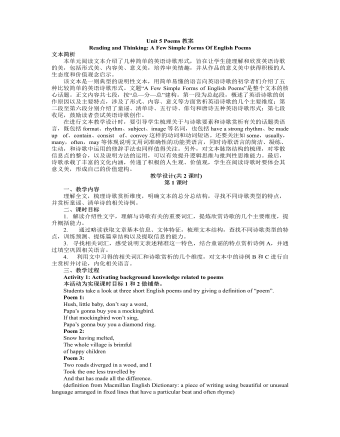
新人教版高中英语选修3Unit 5 Poems教案
本单元阅读文本介绍了几种简单的英语诗歌形式,旨在让学生能理解和欣赏英语诗歌的美,包括形式美、内容美、意义美,培养审美情趣,并从作品的意义美中获得积极的人生态度和价值观念启示。 该文本是一则典型的说明性文本,用简单易懂的语言向英语诗歌的初学者们介绍了五种比较简单的英语诗歌形式。文题“A Few Simple Forms of English Poems”是整个文本的核心话题。正文内容共七段,按“总—分—总”建构。第一段为总起段,概述了英语诗歌的创作原因以及主要特点,涉及了形式、内容、意义等方面赏析英语诗歌的几个主要维度;第二段至第六段分别介绍了童谣、清单诗、五行诗、俳句和唐诗五种英语诗歌形式;第七段收尾,鼓励读者尝试英语诗歌创作。 在进行文本教学设计时,要引导学生梳理关于与诗歌要素和诗歌赏析有关的话题类语言,既包括format、rhythm、subject、image等名词,也包括have a strong rhythm、be made up of、contain、consist of、convey这样的动词和动词短语。
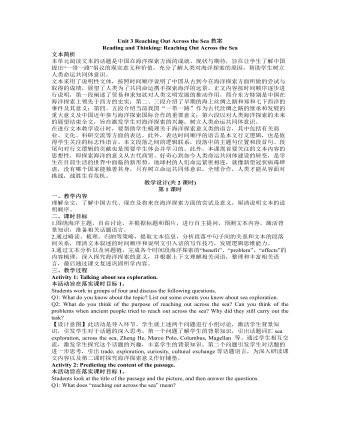
新人教版高中英语选修4Unit 3 Reaching Out Across the Sea教案
本活动旨在落实课时目标3。 Think about the following questions and talk about your own attitude in pairs.Q1: As for this topic,what impresses you the most in the passage?Q2: What do you think of the future of China’s further exploration in sea? Are you in favor of the further exploration?Why or why not? 【设计意图】该活动是一个完全开放性的活动,每个学生都会有不同的答案。运用迁移所学,自由口头表达自己对海洋探索的态度。对于中国海洋探索的未来,每个人的想法是不一样的,有乐观,有担忧,有认为值得投入,也有认为不值得付出太大代价,这里给学生自由表达的空间只要学会有支撑自己观点的事实就可以了,进一步培养学生批判性思维和正确的价值观。 Assignment: 此任务旨在迁移一、二课时所学,培养学生辩证分析问题的能力。 Write about your idea of the future of China’s sea exploration. And add your attitude towards the effort China have made in sea exploration. You’re expected to use the language and the writing technique learnt in the passage.
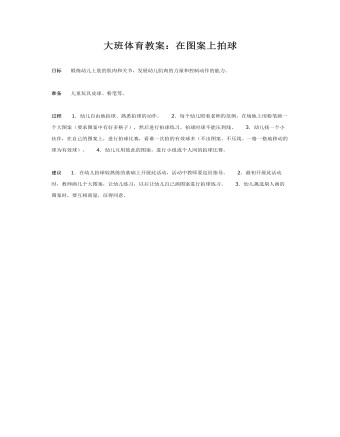
大班体育教案:在图案上拍球
准备 儿童玩具皮球、粉笔等。 过程 1.幼儿自由地拍球、熟悉拍球的动作。 2.每个幼儿照着老师的范例,在场地上用粉笔画一个大图案(要求图案中有好多格子),然后进行拍球练习,拍球时球不能压到线。

中班科学课件教案:奇妙的磁铁-水中取物
2、教学准备:磁铁;探索材料:回形针,玩具,一元硬币,夹子,茶叶罐等铁制材料和非铁制材料:积木,塑料玩具,纸杯,玻璃球,气球……装水的大盆两个;取物工具---篓子、盘子、有磁铁的钓钩、勺子、筷子等;空箱子2只,空盆1个3、教学过程a) 情景引入(出示大盆)师:陈老师遇到一个问题---小弟弟把许多东西一起扔到了这两个玩水的大盆里,这可怎么办呢? 提出问题讨论:怎样才能将这些东西拿出来呢?你们能帮我想想办法吗?

中班科学活动:动物睡觉课件教案
【活动目标】1、探索动物睡觉的秘密。2、尝试用动作表现不同动物的睡觉方式。【活动准备】1、动物睡觉的课件。2、歌曲《小猪睡觉》的音乐,轻音乐两首。【活动重难点】了解不同动物的睡觉方式,并用动作表现。【活动过程】 1、以小客人做客导入活动:(播放歌曲《小猪睡觉》)小朋友们,今天我们班来了一位小客人,你想知道它是谁吗?(小猪)你听一听它在干什么?它是怎样睡觉的?(闭上眼睛睡觉,大耳朵扇扇,小尾巴摇摇。)还发出什么声音?(咕噜噜)
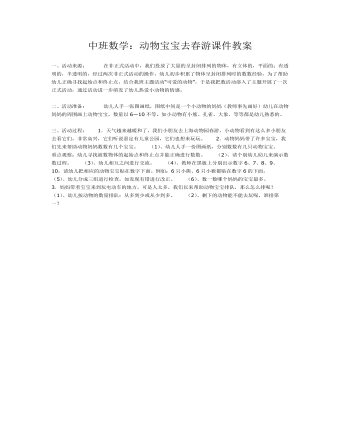
中班数学:动物宝宝去春游课件教案
二、活动准备: 幼儿人手一张图画纸,图纸中间是一个小动物的妈妈(教师事先画好)幼儿在动物妈妈的周围画上动物宝宝,数量以6—10不等。如小动物有小熊、孔雀、大象、等等都是幼儿熟悉的。三、活动过程: 1.天气越来越暖和了,我们小朋友去上海动物园春游,小动物看到有这么多小朋友去看它们,非常高兴,它们听说嘉定有儿童公园,它们也想来玩玩。 2.动物妈妈带了许多宝宝,我们先来帮助动物妈妈数数有几个宝宝。 (1)、幼儿人手一份图画纸,分别数数有几只动物宝宝。 重点观察:幼儿寻找被数物体的起始点和终止点并能正确进行数数。
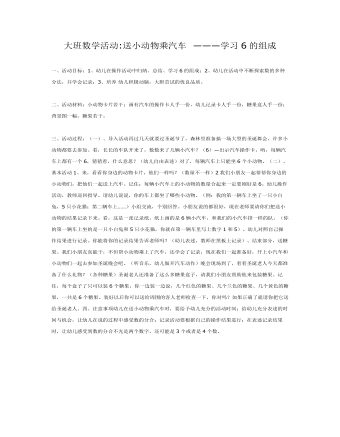
大班数学:送小动物乘汽车课件教案
二、活动材料:小动物卡片若干;画有汽车的操作卡人手一份,幼儿记录卡人手一份,糖果盒人手一份;背景图一幅,糖果若干。 三、活动过程:(一)、导入活动再过几天就要过圣诞节了,森林里准备搞一场大型的圣诞舞会,许多小动物都要去参加。看,长长的车队开来了,数数来了几辆小汽车?(6)—出示汽车操作卡。哟,每辆汽车上都有一个6,猜猜看,什么意思?(幼儿自由表述)对了,每辆汽车上只能坐6个小动物。(二)、基本活动1、来,看看你身边的动物卡片,他们一样吗?(数量不一样)2我们小朋友一起帮帮你身边的小动物们,把他们一起送上汽车。记住:每辆小汽车上的小动物的数量合起来一定要刚好是6。幼儿操作活动,教师巡回指导。请幼儿说说,你的车上都坐了哪些小动物。(例:我的第一辆车上坐了一只小白兔,5只小花猫;第二辆车上……)小组交流,个别回答。小朋友说的都很好,现在老师要请你们把送小动物的结果记录下来。看,这是一张记录纸,纸上画的是6辆小汽车,和我们的小汽车排一样的队,(你的第一辆车上坐的是一只小白兔和5只小花猫,你就在第一辆车里写上数字1和5)。
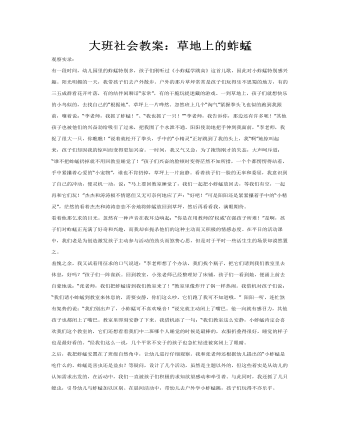
大班社会教案:草地上的蚱蜢
看着他那乞求的目光。忽然有一种声音在我耳边响起:“你是在用教师的‘权威’在强孩子所难!”是啊,孩子们对蚱蜢正充满了好奇和兴趣,而我却在扼杀他们的这种主动而又积极的情感态度。在平日的活动课中,我们老是为创造激发孩子主动参与活动的劲头而煞费心思,但是对于平时一些活生生的场景却漠然置之。 羞愧之余,我又试着用征求的口气说道:“李老师想了个办法,我们找个瓶子,把它们请到我们教室里去休息,好吗?”孩子们一阵雀跃。回到教室,小张老师已经整理好了床铺,孩子们一看到她,便涌上前去自豪地说:“张老师,我们把蚱蜢请到我们教室来了!”教室里像炸开了锅一样热闹。我借机对孩子们说:“我们请小蚱蜢到教室来休息的,需要安静,你们这么吵,它们跑了我可不知道哦。” 阳阳一听,连忙煞有架势的说:“我们别出声了,小蚱蜢可不喜欢噪音!”说完就主动闭上了嘴巴。他一向就有感召力,其他孩子也都闭上了嘴巴。教室里即刻安静了下来。我借机添了一句:“我们教室这么安静,小蚱蜢肯定会喜欢我们这个教室的,它们还想看看我们中二班哪个人睡觉的时候是最棒的,衣服折叠得很好,睡觉的样子也是最好看的。”经我们这么一说,几个平常不安于的孩子也急忙钻进被窝闭上了眼睛。 之后,我把蚱蜢安置在了班级自然角中,让幼儿进行仔细观察。我和张老师还根据幼儿提出的“小蚱蜢是吃什么的、蚱蜢是害虫还是益虫?等疑问,设计了几个活动,虽然是主题以外的,但这些着实是从幼儿的认知需求出发的,在活动中,我们一直被孩子们积极的求知欲望感动和牵引着。与此同时,我还抓了几只蝗虫,引导幼儿与蚱蜢加以区别。在晨间活动中,带幼儿去户外学小蚱蜢跳,孩子们玩得不亦乐乎。
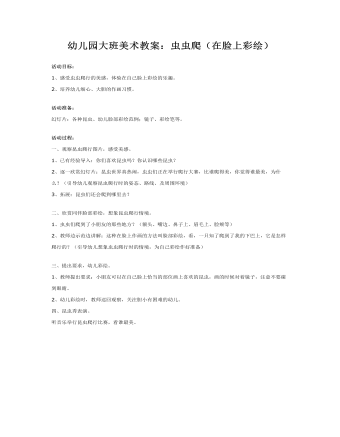
大班美术教案:虫虫爬(在脸上彩绘)
活动准备: 幻灯片:各种昆虫、幼儿脸部彩绘范例;镜子、彩绘笔等。活动过程: 一、观察昆虫爬行图片,感受美感。1、已有经验导入:你们喜欢昆虫吗?你认识哪些昆虫? 2、逐一欣赏幻灯片:昆虫世界真热闹,虫虫们正在举行爬行大赛,比谁爬得美,你觉得谁最美,为什么?(引导幼儿观察昆虫爬行时的姿态、路线、及周围环境) 3、拓展:昆虫们还会爬到哪里去?
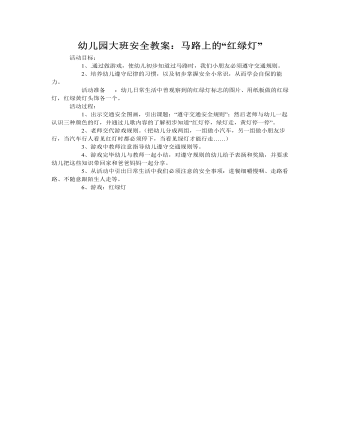
大班安全教案:马路上的“红绿灯”
2、培养幼儿遵守纪律的习惯,以及初步掌握安全小常识,从而学会自保的能力。 活动准备 :幼儿日常生活中曾观察到的红绿灯标志的图片、用纸板做的红绿灯,红绿黄灯头饰各一个。 活动过程: 1、出示交通安全图画,引出课题:“遵守交通安全规则”;然后老师与幼儿一起认识三种颜色的灯,并通过儿歌内容的了解初步知道“红灯停,绿灯走,黄灯停一停”。 2、老师交代游戏规则。(把幼儿分成两组,一组做小汽车,另一组做小朋友步行,当汽车行人看见红灯时都必须停下,当看见绿灯才能行走……)
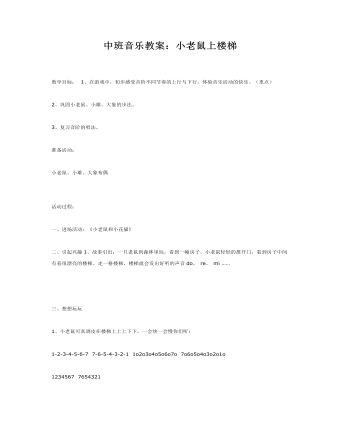
中班音乐教案:小老鼠上楼梯
2、巩固小老鼠、小雄、大象的步法。3、复习音阶的唱法。准备活动:小老鼠、小雄、大象布偶活动过程:一、进场活动:《小老鼠和小花猫》二、引起兴趣1、故事引出:一只老鼠到森林里玩,看到一幢房子。小老鼠轻轻的推开门,看到房子中间有着很漂亮的楼梯。走一格楼梯,楼梯就会发出好听的声音do、 re、 mi ……

